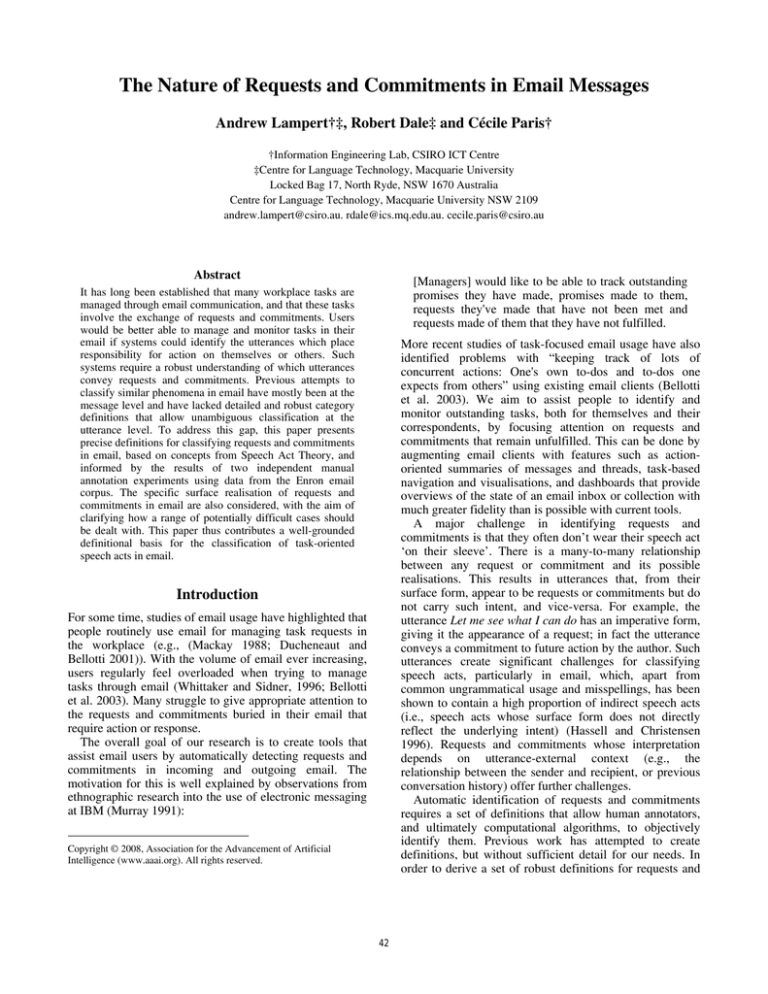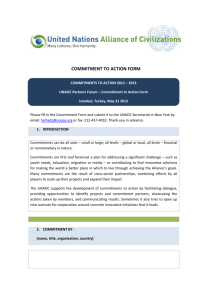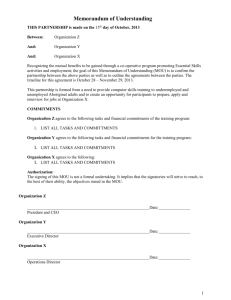
The Nature of Requests and Commitments in Email Messages
Andrew Lampert†‡, Robert Dale‡ and Cécile Paris†
†Information Engineering Lab, CSIRO ICT Centre
‡Centre for Language Technology, Macquarie University
Locked Bag 17, North Ryde, NSW 1670 Australia
Centre for Language Technology, Macquarie University NSW 2109
andrew.lampert@csiro.au. rdale@ics.mq.edu.au. cecile.paris@csiro.au
Abstract
[Managers] would like to be able to track outstanding
promises they have made, promises made to them,
requests they've made that have not been met and
requests made of them that they have not fulfilled.
It has long been established that many workplace tasks are
managed through email communication, and that these tasks
involve the exchange of requests and commitments. Users
would be better able to manage and monitor tasks in their
email if systems could identify the utterances which place
responsibility for action on themselves or others. Such
systems require a robust understanding of which utterances
convey requests and commitments. Previous attempts to
classify similar phenomena in email have mostly been at the
message level and have lacked detailed and robust category
definitions that allow unambiguous classification at the
utterance level. To address this gap, this paper presents
precise definitions for classifying requests and commitments
in email, based on concepts from Speech Act Theory, and
informed by the results of two independent manual
annotation experiments using data from the Enron email
corpus. The specific surface realisation of requests and
commitments in email are also considered, with the aim of
clarifying how a range of potentially difficult cases should
be dealt with. This paper thus contributes a well-grounded
definitional basis for the classification of task-oriented
speech acts in email.
More recent studies of task-focused email usage have also
identified problems with “keeping track of lots of
concurrent actions: One's own to-dos and to-dos one
expects from others” using existing email clients (Bellotti
et al. 2003). We aim to assist people to identify and
monitor outstanding tasks, both for themselves and their
correspondents, by focusing attention on requests and
commitments that remain unfulfilled. This can be done by
augmenting email clients with features such as actionoriented summaries of messages and threads, task-based
navigation and visualisations, and dashboards that provide
overviews of the state of an email inbox or collection with
much greater fidelity than is possible with current tools.
A major challenge in identifying requests and
commitments is that they often don’t wear their speech act
‘on their sleeve’. There is a many-to-many relationship
between any request or commitment and its possible
realisations. This results in utterances that, from their
surface form, appear to be requests or commitments but do
not carry such intent, and vice-versa. For example, the
utterance Let me see what I can do has an imperative form,
giving it the appearance of a request; in fact the utterance
conveys a commitment to future action by the author. Such
utterances create significant challenges for classifying
speech acts, particularly in email, which, apart from
common ungrammatical usage and misspellings, has been
shown to contain a high proportion of indirect speech acts
(i.e., speech acts whose surface form does not directly
reflect the underlying intent) (Hassell and Christensen
1996). Requests and commitments whose interpretation
depends on utterance-external context (e.g., the
relationship between the sender and recipient, or previous
conversation history) offer further challenges.
Automatic identification of requests and commitments
requires a set of definitions that allow human annotators,
and ultimately computational algorithms, to objectively
identify them. Previous work has attempted to create
definitions, but without sufficient detail for our needs. In
order to derive a set of robust definitions for requests and
Introduction
For some time, studies of email usage have highlighted that
people routinely use email for managing task requests in
the workplace (e.g., (Mackay 1988; Ducheneaut and
Bellotti 2001)). With the volume of email ever increasing,
users regularly feel overloaded when trying to manage
tasks through email (Whittaker and Sidner, 1996; Bellotti
et al. 2003). Many struggle to give appropriate attention to
the requests and commitments buried in their email that
require action or response.
The overall goal of our research is to create tools that
assist email users by automatically detecting requests and
commitments in incoming and outgoing email. The
motivation for this is well explained by observations from
ethnographic research into the use of electronic messaging
at IBM (Murray 1991):
Copyright © 2008, Association for the Advancement of Artificial
Intelligence (www.aaai.org). All rights reserved.
42
commitments, we performed two independent annotation
experiments. Results from these experiments strongly
suggest that quite detailed definitions are required to
reliably identify requests and commitments at the utterance
level. Further analysis of the results led us to the robust
definitions for requests and commitments that form the
major contribution of this paper.
The Verb taxonomy defines categories for Request,
Commit, Propose, Amend and Refuse that are all related to
requests and commitments. Unfortunately, the definitions
mix concepts of conversation state and speech acts in a
manner that ties the definition of specific acts to particular
conversation states. So, for example, every Commit act is
defined as being part of the Conclude conversation state.
This requires the creation of separate, overlapping
categories in the taxonomy: Propose and Amend acts differ
only on whether the act occurs at the beginning of a new
conversation or during an ongoing conversation, not due to
differences in the speech act being performed. This also
causes problems in the coverage of the definitions – it is
unclear, for example, how a commitment such as I’ll send
you the document with further details that occurs in a
conversation-initiating email should be classified. More
problematic is the lack of detail in the published
definitions, which leaves many cases without a clearly
correct classification. Examples include lack of clarity
about whether advice or suggestions such as I think you
should include the figures in section 2 should be classified
as Requests. Similarly, no guidance is given for how to
classify conditional requests and commitments, except for
a specific class of acts that request response and
conditionally commit the sender if the recipient responds
(e.g., meeting requests), that are identified as Propose acts.
Goldstein and Sabin (2006) also classified speech acts in
email using a complex, message-level annotation scheme
that includes 23 speech act categories. Like Cohen et al.,
their taxonomy includes conversation state in the speech
act definitions, through the importing of concepts of
forward-looking and backward-looking functions from
DAMSL (Core and Allen 1997). Many of the speech act
categories are distinguished only by their sequence in
conversation. For example, requests and commitments that
respond to previous acts are assigned different categories
depending on whether further response is expected. This
distinction is, however, not captured for requests or
commitments in an email message that initiates an email
conversation. Requests and commitments are also defined
as mutually exclusive – a message cannot simultaneously
request something from the recipient and commit the
message sender. This limitation is problematic for both
message and utterance-level annotation. For an utterance
such as Let me know if you’d like a copy of the document
which requests a response and conditionally commits the
sender to sending the document, there is no appropriate
classification. Our annotation experiments show that such
utterances are frequent in business email.
Leuski (2004) offers yet another speech-act-inspired
taxonomy used to categorise email messages and to
distinguish the roles of different email authors. Leuski’s
taxonomy focuses on requests, distinguishing four separate
request acts based on whether the act seeks information,
advice, action or a meeting. No categories are included to
capture commitments. A general weakness is the lack of
any detail in the category definitions; the only information
provided is a single out-of-context example sentence or
Related Work
Our work builds on influential ideas proposed by
Winograd and Flores (1986) in taking a language-action
perspective and attempting to classify speech acts in email.
While this differs from the approach of most existing email
systems, which routinely treat the content of email
messages as simple bags-of-words, there is a growing body
of research applying ideas from Speech Act Theory
(Austin 1962; Searle 1969) to analyse and enhance email
communication. Most of this work focuses on annotating
speech acts (more properly, speech-act-inspired units) at
the message level, as in (Khosravi and Wilks 1999; Cohen,
Carvalho and Mitchell 2004; Leuski 2004; Goldstein and
Sabin 2006). Like (Corston-Oliver et al. 2004), however,
we observe that a single email message may contain
multiple requests and commitments on a range of tasks and
topics. We thus focus on a more fine-grained utterancelevel classification.
In our attempts to define requests and commitments, we
looked to previous work that has classified such
phenomena in email. As we outline below, all the existing
definitions have significant problems: either being tied to a
particular domain, mixing conversation state into the
definition of speech acts, or lacking detail that allows
unambiguous classification at the utterance level.
One early message-level annotation scheme was defined
by Camino et al. (1998). They analysed requests and
corresponding answers in the context of exploring the
efficacy of structured email messages. They classified
requests based on the form of the expected answer (e.g.,
one of list choice, several of list choice, date, time, free
text), and also distinguished requests requiring an email
response from those requiring external action. One
weakness is in the lack of consideration of conditional
requests, other than those that request acknowledgement of
sent information being useful or correct. The classification
taxonomy also excludes any commitment categories.
Khosravi and Wilks (1999) focus on classifying three
classes of requests: Request-Action, Request-Information
and Request-Permission. Unfortunately, the cue-phrasebased rules they define for identifying requests are very
specific to the computer support domain from which their
email corpus was drawn. Their categorisation also mixes
aspects of the surface realisation (direct/indirect) with the
speech act function (action/information/permission), which
as we discuss later, is not desirable.
Cohen, Carvalho and Mitchell (2004) developed
separate taxonomies of Verbs and Nouns to embody their
definitions for message-level “Email Act” classification.
43
phrase for each category. This makes the categories unable
to be easily used for manual annotation or computational
classification.
The SmartMail system (Corston-Oliver et. al. 2004)
attempts to automatically extract and reformulate action
items from email messages for the purpose of adding them
to a user's to-do list. Unlike the other taxonomies discussed
which focus on categorising email at the message level, the
SmartMail taxonomy is designed to be applied at the
sentence level, and is thus closest to our requirements.
For requests and commitments, there are three categories
of interest: Task, Meeting and Promise. No mention is
made of the use of the Promise category, and no
explanation is given for what constitutes a promise.
Meetings are defined without further detail or discussion as
“a proposal to meet”. Tasks are sentences that “look like an
appropriate item to add to an ongoing ‘to do’ list”, with the
explicit exclusion of simple factual questions on the basis
that the act of responding fulfils any associated obligation
(meaning nothing is placed on a task list). Unfortunately,
what constitutes a “simple factual question” is not
specified, and it is not clear how to distinguish such
requests from those that would result in a new action being
added to a task-list. For example, an utterance such as
When is the contract expiring? might be answered
immediately without the need to add anything to a task list
if the recipient knows the response. Alternatively, it might
require the recipient to issue requests to other people or
systems; tasks that might reasonably be added to the
recipient’s task list. In either case, an obligation is placed
on the recipient, and unlike Corston-Oliver et al., we
believe this should be reflected in the classification of the
utterance as a request under either interpretation.
Annotators are also restricted to applying a single tag to
each sentence, meaning that a sentence cannot embody
both a request (Task) and a commitment (Promise), which
as we have illustrated earlier, is an artificial restriction.
In general, none of the existing definitions of requests or
commitments provide enough detail to robustly and
unambiguously support the classification of requests and
commitments at the utterance level. As we outline below,
our annotation experiments show that there are many cases
that don’t resemble the simple canonical examples forming
the basis of the surveyed definitions. This may be partly
due to the focus on message level classification; while
looser definitions may be sufficient to achieve reasonable
human agreement that an email contains a request or a
commitment, it is more difficult and subjective to
determine which of the utterances in the message actually
embody the request or commitment. This more challenging
problem requires a much more tightly defined set of
definitions to guide utterance-level categorisation.
First Experiment
Our first experiment used guidelines similar to many of
those surveyed. We defined requests as sentences carrying
an expectation that the recipient of the email should take
action, and commitments as sentences carrying an
expectation that the sender is promising future action from
themselves or on behalf of another person. Our definitions
are more fully described in (Lampert et al., 2007).
For all our annotation experiments, we used the database
dump of the Enron email corpus released by Andrew Fiore
and Jeff Heer.1 This corpus is the result of a substantial
amount of processing of the contents of the raw Enron
corpus, including automated removal of duplicate email
messages and normalisation of sender and recipient names.
The resulting corpus has just over 250,000 email messages.
Like all publicly released versions of the Enron email
corpus, no attachments are included. The data annotated in
our experiments is all extracted from the message bodies.
Annotators marked 350 sentences from 54 email
messages. Inter-annotator agreements between three expert
annotators (the authors) are shown in Table 1. The most
significant sources of disagreement occurred for
conditional commitments and implicit requests.
Table 1:Cohen’s Kappa agreements for First Manual
Annotation Experiment
A+B
B+C
A+C
3-Way
Commitments 0.62
0.55
0.45
0.54
Requests
0.79
0.74
0.83
0.78
Second Experiment
Analysis of disagreements from our first experiment led us
to include greater detail and guidance for categorising edge
cases. In particular our revised guidelines specified that
both requests and commitments should be classified as
conditional or unconditional, to emphasise the inclusion of
conditional requests and commitments. We also asked
annotators to mark requests and commitments as either
implicit or explicit, hoping to encourage more careful
consideration of implicit speech acts. Annotators marked
750 sentences from 350 email messages. Agreements for
our second experiment (same three annotators) are
summarised in Table 2. Agreement increased for both
requests and commitments from our first experiment,
particularly for commitments. The improved agreement
was due largely to better guidance about how to annotate
conditional commitments (and to a lesser degree, requests).
Additional edge case analysis of annotator disagreements
led to our final definitions, presented in the next section.
Table 2: Cohen’s Kappa agreements for Second
Annotation Experiment
A+B
B+C
A+C
3-Way
Commitments 0.85
0.63
0.73
0.74
Requests
0.87
0.74
0.79
0.80
Manual Annotation Experiments
We began our exploration through annotation experiments,
to determine levels of human agreement in identifying
requests and commitments in email.
1
44
http://bailando.sims.berkeley.edu/enron/enron.sql.gz.
owner of the inbox in which we are classifying email
messages). A useful, though not exhaustive, diagnostic test
for determining whether an utterance corresponds to a
request is to ask whether the utterance could result in a task
being added to a ‘to-do’ list. Requests for action,
information, permission, confirmation, agreement,
evaluation, interpretation, sympathy (Labov and Fanshel
1977) can all, under certain conditions, be considered as
actions that might be listed on a to-do list.3
In the data we have examined, requests typically place
an obligation on the recipient to either schedule or
complete an action, or to respond by providing information
to the sender. Some linguists have previously distinguished
between speech acts that require a physical response from
those that require a verbal or information response – e.g.,
(Sinclair 1975). We follow the approach of Searle’s
original taxonomy, and make no such distinction in our
definition of requests. We thus explicitly include questions
requiring an informational response as requests, since they
are attempts by the sender to get the recipient to answer,
i.e., to perform a speech act. So both of the following
constitute requests in our model:
Defining Requests and Commitments
The concepts and definitions presented are based on
analysis of the results from our two annotation experiments
described in the previous section. In particular, analysis of
cases of disagreement from these experiments provided
insight into the edge cases of classification.
Basic Concepts
The ontological foundation of our taxonomy is the notion
of an action. Actions are carried out by agents; a request
is, in essence, the placing of an obligation by one agent on
another agent to carry out the requested action; a
commitment is the taking on, by some agent, of an
obligation to carry out an action. Both requests and
commitments may be conditional, in that some state must
hold before the request or commitment can be carried out.
In line with the above, requests and commitments are
formally defined as tuples of either three or four elements:2
Request = ⟨Action, Requestor, Requestee, [Condition]⟩
Committment = ⟨Action, Committor, Committee, [Condition]⟩
(1) Please attend the meeting this morning.
We also consider the realisation of a request or
commitment to be distinct from the request or commitment
itself. This allows us to talk of different realisations of the
same request or commitment, so that a statement like I
made this request twice already makes sense. It also allows
us to adopt the traditional distinction between direct and
indirect speech acts as alternative means of realising
requests and commitments. So, we also have:
(2) When does your flight arrive?
Note that many information requests are often so
straightforward or simple to attend to that we would not
typically think of them as being candidates for inclusion in
a ‘to-do’ list, perhaps on the grounds that it would take just
as much effort to add the item to such a list as it would to
respond to it. However, they still require the recipient to
act, and so they constitute requests in our approach.
Requests for information are typically surface form
questions. Not all questions are requests, of course,
rhetorical questions being one class of non-request
questions. 4
Another category of question that our annotation
guidelines rule out as not being a kind of request are what
we refer to as pleasantries. These are defined as polite
social utterances that, while often resembling requests for
information (e.g., How are things?), place on the recipient
only a very weak or optional obligation to respond or act.
One exception to this rule is when an email message
contains only sentences that would normally be marked as
pleasantries. In such cases, we elevate such sentences to
UtteredRequest = ⟨Direct/Indirect, Utterance, Request⟩
UtteredCommittment = ⟨Direct/Indirect, Utterance, Commitment⟩
Sometimes it is not easy to determine the locus of a request
or commitment in a text, i.e. the actual piece of an email
message that corresponds to the request or commitment as
opposed to something else. In the work described here, we
restrict ourselves to cases where it is fairly clear that the
locus is an individual sentence, but there are cases where
this is not so straightforward; see (Lampert et al. in
submission) for a detailed discussion of these edge cases.
We will generally use the term utterance as a sizeindependent label for the text fragments used to convey
requests or commitments.
Requests
3
We might wish to define subcategories of Request
corresponding to each of these distinct types. This is
compatible with the approach we adopt here, although in
our view the consequent complexity it adds to the
annotation task means that such sub-categorisation is of
questionable value.
4
Determining whether or not something is a rhetorical
question as opposed to a real question may require
reasoning about the context; consider a question like Do
we really want to do this? We will address this issue in
future work.
For present purposes, we can think of requests as the
actionable utterances in an email message, from the pointof-view of a particular email recipient (defined as the
2
There are other elements we might include in a formal
definition of Requests and Commitments; an obvious one
is a date by which some action is to take place. To
simplify discussion here, we leave the elaboration of these
elements for future work.
45
the status of a request, on the basis that ignoring even a
weak obligation in this context could be deemed
inappropriate.
One interesting consequence of our distinction between
an underlying request and its realisation in linguistic form
is that it is possible for different requests to be realised in
the same way. For example, the sentence Can you attend
this afternoon? can, in some contexts, be classified as both
a request for information (‘Are you coming?’) and a
request for action (‘Make sure you attend this afternoon!’).
Various factors will influence the classification decision,
including details about the organisational relationship
between sender and recipient. For example, if the above
sentence were uttered by a manager to their direct report,
the power relationship could easily dictate that it should be
interpreted as a request for action, while this interpretation
may be less likely were the email sent from the subordinate
to their manager.
Requests not to act or inform (also referred to as
prohibitives by some researchers) are not classified as
requests, since they are typically not something that can be
actioned, managed or completed in the same way as the
task requests in which we are interested.
commitments are not considered commitments to act, as
there is, by definition, no future action to follow-up on.
Another interesting border case is the collection of
socially-motivated sentences that resemble commitments
but assign little or no obligation on any party to act. As for
requests, we call such sentences pleasantries. The inclusion
of such utterances is largely formulaic, and their function is
not primarily to commit to any future action, but rather to
satisfy the social norms of communication. Variants on Let
me know if you have any questions are particularly
common. We require the context of the entire email
message to be considered in order to distinguish between
when such a statement is present due to social convention
and when it functions as an actual offer or commitment for
future action or response.
Conditionality
Both requests and commitments may be conditional, in the
sense that the scheduling or execution of the specified
action is expected only if some stated condition is satisfied.
For both requests and commitments, the condition is
usually stated in the utterance containing the request or
commitment. It may, however, be stated elsewhere in the
email message, and understood to apply to the request or
commitment utterance, as in the following example:
Commitments
We define commitments as utterances that promise or offer
future action by either the sender or an identifiable thirdparty: in terms of the formal definition provided earlier,
although the Committor and the Committee are often the
same person, this need not be the case, as the distinction
between the following examples illustrates:
(5) Are you coming to the meeting? If so, send me
items for the agenda by 2pm.
Note also that conditional commitment binds the relevant
party to action only when the stated condition is satisfied:
(6) I’ll send a draft if Harry responds before Friday.
(3) I’ll send you the minutes on Friday.
Surface Realisations
(4) Cathy will send you the minutes on Friday.
As noted, we distinguish underlying requests and
commitments from their surface linguistic form. We can
then categorise their realisations as either direct or indirect.
Direct requests state the actual request explicitly, either
in the form of an imperative command (see example (1)
above) or as a question where a response to the literal
interpretation of the question would result in a speech act
with the required content (see example (2) above). Note
that the content may be information, permission,
interpretation and so on, as noted in our definition.
Indirect Requests may or may not state the required
action, but don’t explicitly instruct the recipient to act or
respond with the required speech act. Thus, (7) and (8) are
direct requests, while (9) is indirect, since a literal response
would be a yes/no answer.
A third-party agent who is committed to act can be either
another person, a group of people or some organisation; so
an important element of characterising a commitment is the
identification of the intended agent of that action;
effectively, whose to-do list does the action belong to?
Promises of action by the sender may not explicitly state
the sender as the agent of the future action. The deciding
factor is whether the recipient would reasonably assume
that the sender is taking responsibility for the future action.
For example, in one of our annotated emails, the sender
notes More to follow at the end of their email. Although
not stated explicitly, all annotators agreed that this was a
commitment to send more information by the sender.
In the case of committing third-parties to future action,
there must be an identifiable third-party agent of the action,
as in example (4) above. A consequence of this is that we
do not consider ‘unassigned’ actions to be commitments. A
typical example would be Lunch will be served at the
meeting, but ultimately the wider context of the message
will determine whether or not there is a specified agent.
An interesting edge case stems from commitments not to
act, as in I won’t send any further updates. Such negative
(7) Please send me my curves and trades for Jan 18.
(8) What were they?
(9) Can you send my curves and trades for Jan 18?
Similarly, direct commitments state the promise for future
action explicitly. Indirect commitments do not state the
promise to complete future action. Note that in either case,
as for requests, the actual action may or may not be stated
46
explicitly. So, (10) and (11) represent direct commitments,
while (12) is considered indirect.
Goldstein, J. and Sabin, R. E. 2006. Using Speech Acts to
Categorize Email and Identify Email Genres. Proceedings
of the 39th Hawaii International Conference on System
Sciences, pp. 50b.
Hassell, L. and Christensen, M. 1996. Indirect Speech Acts
and Their Use in Three Channels of Communication.
Proceedings of the First International Workshop on
Communication Modeling - The Language/Action
Perspective, Tilburg, The Netherlands.
Khosravi, H and Wilks, Y. 1999. Routing email
automatically by purpose not topic. Natural Language
Engineering, Volume 5, Issue 03, pp. 237-250
Labov, W. and Fanshel, D. 1977. Therapeutic Discourse:
Psychotherapy as Conversation, Academic Press.
Lampert, A., Paris, C. and Dale, R. 2007. Can Requestsfor-Action and Commitments-to-Act be Reliably Identified
in Email Messages? In Proceedings of the 12th
Australasian Document Computing Symposium, pp. 48-55.
Melbourne, Australia.
Lampert, A., Dale, R. and Paris, C. (in submission). Why
Identifying Requests and Commitments in Email Messages
is Hard. Submitted to the Coling 2008 Workshop on human
judgements in Computational Linguistics, Manchester, UK.
Leuski, A. 2004. Email is a stage: discovering people roles
from email archives. Proceedings of Annual ACM
Conference on Research and Development in Information
Retrieval, Sheffield, UK.
Mackay, W. E. 1988. More Than Just a Communication
System: Diversity in the Use of Electronic Mail. ACM
conference on Computer-supported cooperative work, pp.
344-353. Portland, Oregon, USA: ACM Press.
Murray, D. E. 1991. Conversation for Action: The
Computer Terminal As Medium of Communication. John
Benjamins Publishing Co.
Searle, J. R. 1969. Speech Acts: An Essay in the
Philosophy of Language. Cambridge University Press.
Sinclair, J. and Coulthard, R. M. 1975. Towards and
Analysis of Discourse - The English used by Teachers and
Pupils. Oxford University Press.
Whittaker, S. and Sidner, C. 1996. Email Overload:
exploring personal information management of email.
ACM Computer Human Interaction conference, pp. 276283. ACM Press.
Winograd, T. and Flores, F. 1986. Understanding
Computers and Cognition. Norwood, New Jersey, USA:
Ablex Publishing Corporation.
(10) I’ll send you the document today.
(11) I’ll do it.
(12) Leave it to me.
Conclusion
We have presented a set of robust definitions for requests
and commitments in email communication that we hope
will be widely applicable within the email research
community. These definitions are based on Speech Act
Theory, and informed by the results of two independent
experiments in which requests and commitments were
manually annotated in approximately 1000 sentences from
the Enron email corpus. We cleanly separate the
definitions of requests and commitments from aspects of
their surface realisation, and thus are able to neatly capture
distinctions between alternate renderings of the same
underlying request or commitment act. In future work, we
aim to develop machine-learning based techniques for the
annotation of requests and commitments in line with the
characterisations laid out here, further extending the
approach described in (Lampert et al. 2007).
References
Austin, J. L. 1962. How to do things with words. Harvard
University Press.
Bellotti, V., Ducheneaut, N., Howard, M. and Smith, I.
2003. Taking Email To Task: The Design and Evaluation
of a Task Management Centred Email Tool. Computer
Human Interaction Conference, Ft Lauderdale, Florida,
USA.
Camino, B. M., Milewski, A. E., Millen, D. R., Smith, T.
M. 1998. Replying to email with structured responses.
International Journal of Human-Computer Studies,
Volume 48, Issue 6, pp. 763-776.
Cohen, W. W., Carvalho, V. R. and Mitchell, T. M. 2004.
Learning to Classify Email into "Speech Acts". In D. Lin
and D. Wu (eds.). Conference on Empirical Methods in
Natural Language Processing, pp. 309-316. Barcelona,
Spain: Association for Computational Linguistics.
Core, M. and Allen, J. 1997. Coding dialogs with the
DAMSL annotation scheme. AAAI Fall Symposium on
Communicative Action in Humans and Machines, pp. 2835. Cambridge, MA.
Corston-Oliver, S. H., Ringger, E., Gamon, M. and
Campbell, R. 2004. Task-focused summarization of email.
ACL-04 Workshop: Text Summarization Branches Out.
Ducheneaut, N. and Bellotti, V. 2001. E-mail as habitat: an
exploration
of
embedded
personal
information
management. Interactions 8(5): 30-38.
47









